by Fred
Sinfield ©
(click on photos to enlarge image)
A BOX AND A BURNER
A new dealer was at a regular monthly fair with an
interesting collection of items that mainly originated
from the Middle East. One piece that caught the
collector’s eye was a small circular box with an
engraved crown on the lid. On closer inspection was a
surprise as on the base was punched Tiffany & Co.
A lift off lidded gold box engraved with a crown that
has an act of regicide associated with it. (on the right)
Having purchased the 14kt gold box with a lift off lid
that weighs 47.6grams and measures 50x20mm, a check of
the other punches revealed that the “M” was for Louis
Moore, president of the Company from 1947 to 1956 and
that '21054' was a design created in 1927. Scratched on
the base is '15446', which is probably Tiffany’s stock
code. (photos below)
|
 |
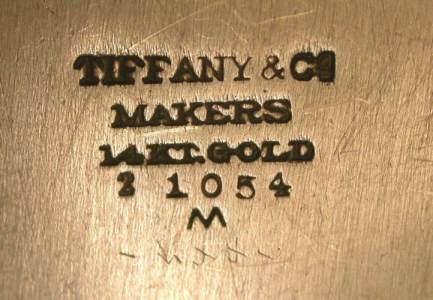
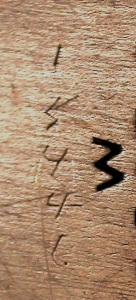 |
The base of the box with the punches “Tiffany
& Co. Makers. 14kt Gold. '21054' and 'M'. The letter
was for Louis Moore, president of the Company from
1947 to 1956 and the numeric code indicated that
1927 was the year of the design (on the left)
On the base of the Tiffany box is scratched '15446',
the significance of which is uncertain but is
probably a Tiffany retail stock code. (on the right)
|
Months later, having established an
acquaintanceship with the dealer, the curious
collector brought up the question of what was
thought to be a fantasy crown. Why he did not do
this in the first instance is unknown, as the dealer
knew the story that had its beginning after the
First World War with the enthronement of Faysal I as
King of Iraq in Baghdad in 1921.
His son succeeded him in 1933 as King Ghazi
(1912-39) but died in an accident so his infant son,
born in Baghdad on 2nd May 1935, succeeded to the
throne under the tutelage of an uncle who acted as
regent until the young king attainted his majority.
Amongst the gifts from the Jewish community of
Baghdad to celebrate the King Faysal II Coming of
Age was the Tiffany gold box engraved with the crown
of Iraq. Confirmation that this was indeed the Iraqi
crown was via two sources being the Iraqi flag of
that period and the engraving on a locally made
silver salver, circa 1950, featuring a bust of the
King.
A silver salver, circa 1950, with the bust of the
King Faysal II that helped to identify and confirm
the crown of Iraq on the Tiffany gold box (on the
right)
|
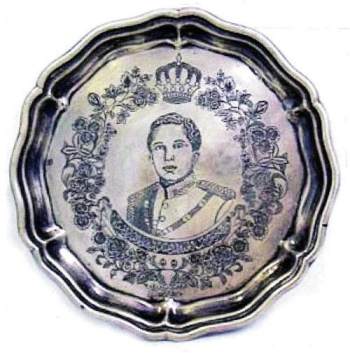 |
The reign of King Faysal II was short as an act of regicide
ended his life on 14th July 1958, also killed were members of
his family, associates and even the family pets. After this
bloody event, came the disposal of assets that included the gold
box, which later came into the possession of the Baghdad dealer
who eventually fled the country for the safety of Jordan.
From there, the dealer managed to take the box with him into
exile and offered it for sale at the collectors fair.
Amongst the other assets of the murdered king were incense
burners.
These large and important silver pieces of hollow ware are in
use thorough out the Middle East. The freestanding burners known
as a mabakhir or mubkhara hold hot charcoals upon which is
sprinkled incense and passed from hand to hand to appreciate and
enjoy the fragrance. The shape of these burners stylized, over
time, has the now familiar flared open top.
The one illustrated originated from the adjacent Kingdom of
Saudi Arabia. The story of that modern kingdom began on 18th
September 1932 when King Fu`ad ascended the throne. In recent
decades wealth poured into the country due to the oil exports
and imports increased.
As a token of appreciation, during the reign of King Faysal of
Saudi Arabia, was a presentation to an ambassador of a mabakhir.
The piece is 280cms high, weighs approximately 58ounces and came
from the workshop of Ahmad Bader of Mecca who engraved his name
upon it. Fig 5 & 6
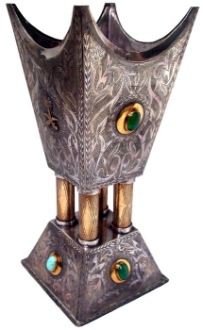
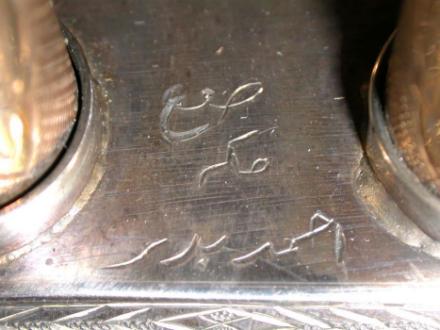 |
A freestanding mabakhir or incense burner
with a flared open top for hot charcoal, onto which
is sprinkled incense and passed from hand to hand.
(on the left)
The mabakhir weighing approximately 58ounces that
came from the workshop of the silversmith Ahmad
Bader of Mecca was a presentation by the Saudi
government in acknowledgement for services rendered.
(on the right)
|
There are no assay marks as the reputation of the
silversmith was the guarantee of the quality, confirmation of
this being the presentation by the Saudi government. The silver
is at least .917, being the standard of both the silver and gold
coins of the realm.
Set in silver gilt around the base of the mabakhir are alternate
turquoise and green stone cabochons and on the bowl are green
stones alternating with the arms of Saudi Arabia. The overall
decoration is of floriated design with the four supporting
columns in silver gilt. This is similar to but not as impressive
as the silver and gilt incense burner set with emeralds and
turquoise presented as a State gift to President Nixon as seen
on - http://nixon.archives.gov/exhibits/gifts/htmlversion.php?item=4
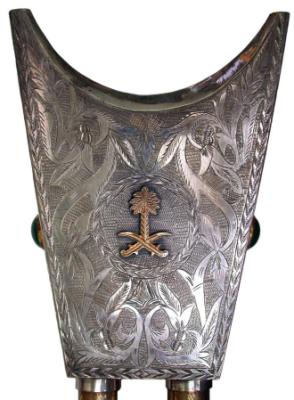
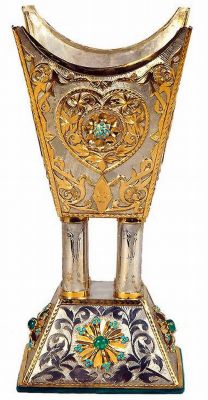 |
The overall decoration of the incense burner
is of floriated design with the arms of Saudi Arabia
and four supporting columns in silver gilt (on the
left)
The silver and gilt incense burner, set with
emeralds and turquoise, presented as a Head of State
gift to President Nixon. (on the right)
|
The story of incense, its use and importance to the region makes
fascinating reading.
Just when nomads realized the dried sap of the tree of the genus
Boswellia of the Burseraceae family gave off the pungent sweet
odour when heated is unrecorded but occurred centuries ago.
The gum is still obtained by the ancient method of making
incisions in the trunk of the tree that exudes as a milk-like
sap which hardens on exposure to air, collected then broken into
small pieces for use as a fumigate.
The Sultanate of Oman acknowledges the importance of incense by
erecting a large bowl in the traditional form in the centre of a
roundabout. On each corner of the base is another
important object being rose water sprinklers. These have
religious as well as secular usages from Spain right through to
China and made mainly silver or sometimes gold in a variety of
styles and even gem encrusted. (Footnote 1).
It is important for future reference to establish of the
providence and recording the information of the box and the
mabakhir that had an association with the ruling families in
adjacent Middle Eastern kingdoms.
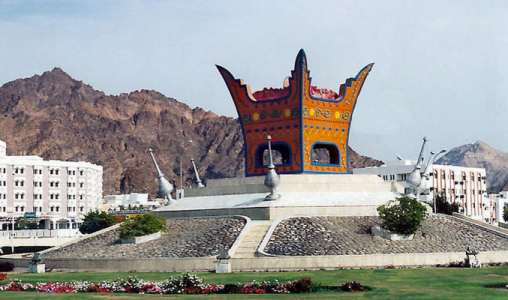
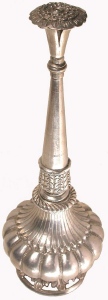 |
Incense, its use and importance to the region
is acknowledged by the Sultanate of Oman by a large
burner in the centre of a roundabout together with
rose water sprinklers at each corner. (on the left)
Usually made of heavy gauge silver is a typical rose
water sprinkler with a bulbous reservoir and a
perforated head in the form of a rose, widely used
for religious or secular purposes from Spain through
to China (on the right)
|
Acknowledgement to the private collector who made the items
available for inclusion in this article.
Footnote 1:
Various museums have rose water sprinklers such as the Topaki
Sarayi Muzesi, Istanbul; the Hermitage, St Petersburg; the
National Museum of Singapore and the Smithsonian to name a few.
Bibliography
Choo, A.A. 1984. A Guide to the Collections. National Museum,
Singapore.
Zebrowski, M. 1997. Gold, Silver & Bronze from Mughal India.
Alexandria Press, London
Fredric Sinfield © - 2007 -
|
|
|
 ASSOCIATION OF SMALL COLLECTORS OF ANTIQUE SILVER
ASSOCIATION OF SMALL COLLECTORS OF ANTIQUE SILVER ASSOCIATION OF SMALL COLLECTORS OF ANTIQUE SILVER
ASSOCIATION OF SMALL COLLECTORS OF ANTIQUE SILVER